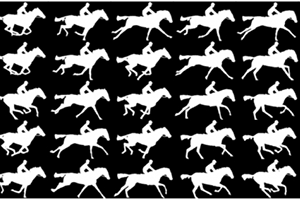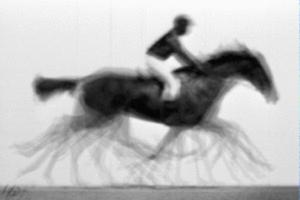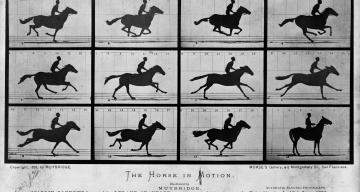Temporal Resolving Power
Understanding Muybridge's The Horse in Motion
Eadweard Muybridge's The Horse in Motion, a motion picture depicting a horse's movement, is informative about how LCLS studies biomolecules.
This film is a series of images scrolled through with several cameras used to take snapshots to understand the horse's movement and action. Each image can be considered one point in time of the horse running. To understand a biomolecule, similar multiple spatially resolved time points during a biological reaction or dynamics must be seen.


If the camera exposure time is longer than the motion of interest, the motion in the produced image is blurred because there would be contributions from all images in time.
When presented with the averaged-out image and asked to ascertain parts of the horse that are important for the action (i.e., running down the track), it may seem as if the easily resolved parts (the body, tail, and head) are the most important for the action, but this would be an incomplete takeaway.
How does this relate to LCLS?
X-rays and electrons are probes used to determine the high-resolution structures of biological macromolecules. However, most of these measurements are performed with long pulses with samples at cryogenic temperatures because X-rays and electrons are inherently destructive to macromolecules.
The freezing process can alter the state of the biomolecule, and since freezing is not instantaneous (10s of µs for single particles and ms+ for 3D crystals), different biomolecules in a crystal or ensemble might end up in different conformations that end up being averaged-out in the final structure, which is equivalent to more than one (up to all) of the different images of the horse running being combined into the determined structure.

LCLS is fundamentally different from synchrotrons or cryo-EM sources. X-rays produced by LCLS are nominally 40 fs long and can be even shorter, surpassing conventional radiation damage and allowing samples to be measured at room temperature under near-physiological conditions. The 40 fs pulse duration is the equivalent of the camera shutter.
Atomic motion occurs minimally in 40 fs, therefore LCLS allows greater time resolution of biomolecules than any other source in the world, allowing the individual images of Muybridge's horse to be much better than any other tool.


